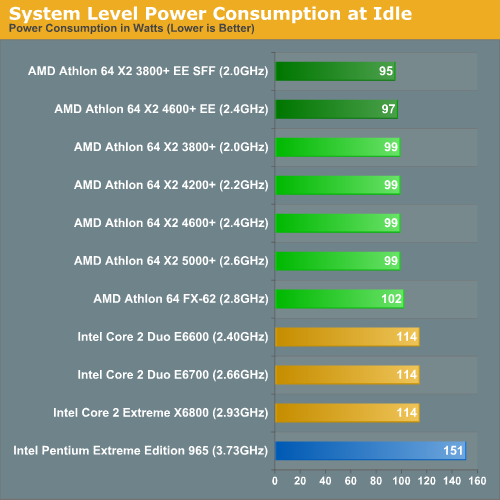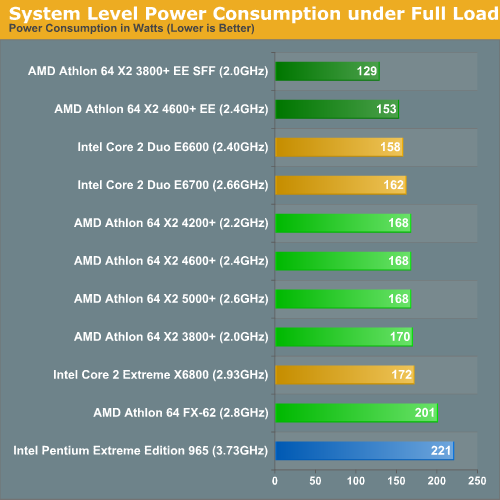Intel's Core 2 Extreme & Core 2 Duo: The Empire Strikes Back
by Anand Lal Shimpi on July 14, 2006 12:00 AM EST- Posted in
- CPUs
Power Consumption: Who is the king?
Intel promised us better performance per watt, lower energy consumed per instruction, and an overall serious reduction in power consumption with Conroe and its Core 2 line of processors. Compared to its NetBurst predecessors, the Core 2 lineup consumes significantly lower power - but what about compared to AMD?
This is one area that AMD is not standing still in, and just days before Intel's launch AMD managed to get us a couple of its long awaited Energy Efficient Athlon 64 X2 processors that are manufactured to target much lower TDPs than its other X2 processors. AMD sent us its Athlon 64 X2 4600+ Energy Efficient processor which carries a 65W TDP compared to 89W for the regular 4600+. The more interesting CPU is its Athlon 64 X2 3800+ Energy Efficient Small Form Factor CPU, which features an extremely low 35W rating. We've also included the 89W Athlon 64 X2s in this comparison, as well as the 125W Athlon 64 FX-62.
Cool 'n Quiet and EIST were enabled for AMD and Intel platforms respectively; power consumption was measured at the wall outlet. We used an ASUS M2NPV-VM for our AM2 platform and ASUS' P5W DH Deluxe for our Core 2 platform, but remember that power consumption will be higher with a SLI chipset on either platform. We used a single GeForce 7900 GTX, but since our power consumption tests were all done at the Windows desktop 3D performance/power consumption never came into play.
We took two power measurements: peak at idle and peak under load while performing our Windows Media Encoder 9 test.

Taking into consideration the fact that we were unable to compare two more similar chipsets (we will take a look back at that once retail Intel nForce 5 products hit the shelves), these power numbers heavily favor Intel. The releative power savings over the Extreme Edition 965 show just how big the jump is, and the ~15% idle power advantage our lower power AMD motherboard has over the Intel solution isn't a huge issue, especially when considering the performance advantage for the realtively small power investment.

When looking at load power, we can very clearly see that AMD is no longer the performance per watt king. While the Energy Efficient (EE) line of X2 processors is clearly very good at dropping load power (especially in the case of the 3800+), not even these chips can compete with the efficiency of the Core 2 line while encoding with WME9. The bottom line is that Intel just gets it done faster while pulling fewer watts (e.g. Performance/Watt on the X6800 is 0.3575 vs. 0.2757 on the X2 3800+ EE SFF).
In fact, in a complete turn around from what we've seen in the past, the highest end Core 2 processor is actually the most efficient (performance per Watt) processor in the lineup for WME9. This time, those who take the plunge on a high priced processor will not be stuck with brute force and a huge electric bill.










202 Comments
View All Comments
Anand Lal Shimpi - Friday, July 14, 2006 - link
Corrected, it was a misprint.Take care,
Anand
Zorba - Friday, July 14, 2006 - link
Why is the article talking about how Intel is killing AMD on power consumption when AMD is on the top for both idle and load? If you are doing a performance/watt ratio you need to show that on the graph. This page (page 7) just makes the how article look completely baised.Calin - Friday, July 14, 2006 - link
Because the EE SFF processors were hard to obtain by Anandtech even for testing purposes. I'm not sure they are available in retail market any more than Conroe isAnand Lal Shimpi - Friday, July 14, 2006 - link
The Core 2 Extreme X6800 has a performance per watt score of 0.3575 in WME9 compared to 0.2757 for the X2 3800+ EE SFF. I'll put together a performance per watt graph now and see if I can stick it in there.Take care,
Anand
Anand Lal Shimpi - Friday, July 14, 2006 - link
I included the performance per watt scores I mentioned above in the review now, hopefully that will make things a little more clear.Take care,
Anand
JarredWalton - Friday, July 14, 2006 - link
I don't see the chart, Anand - I hope I didn't accidentally overwrite your change. Sorry!MrKaz - Friday, July 14, 2006 - link
Don't put it because it's a biased chart,Why based on WM9 benchmark? Why not one of the others?
Why put it now, if you never put it when A64 was killing the P4s?
coldpower27 - Friday, July 14, 2006 - link
Because AMD didn't real make a big deal about the performance per watt intiative back in the day. They focused on their price/performance instead.MrKaz - Friday, July 14, 2006 - link
So?Just because Intel focuses now on that Anandtech must be obliged to put it?
So for you where was the price/performance (A64 vs P4) charts on Anandtech reviews?
coldpower27 - Friday, July 14, 2006 - link
Yeah, due to their making people aware of it, it has now become a issue.It was only after Prescott, that we became more aware that thermals were starting to get out of control and paid more attention to wattage numbers.
Price/Performance is not as hard to calculate.